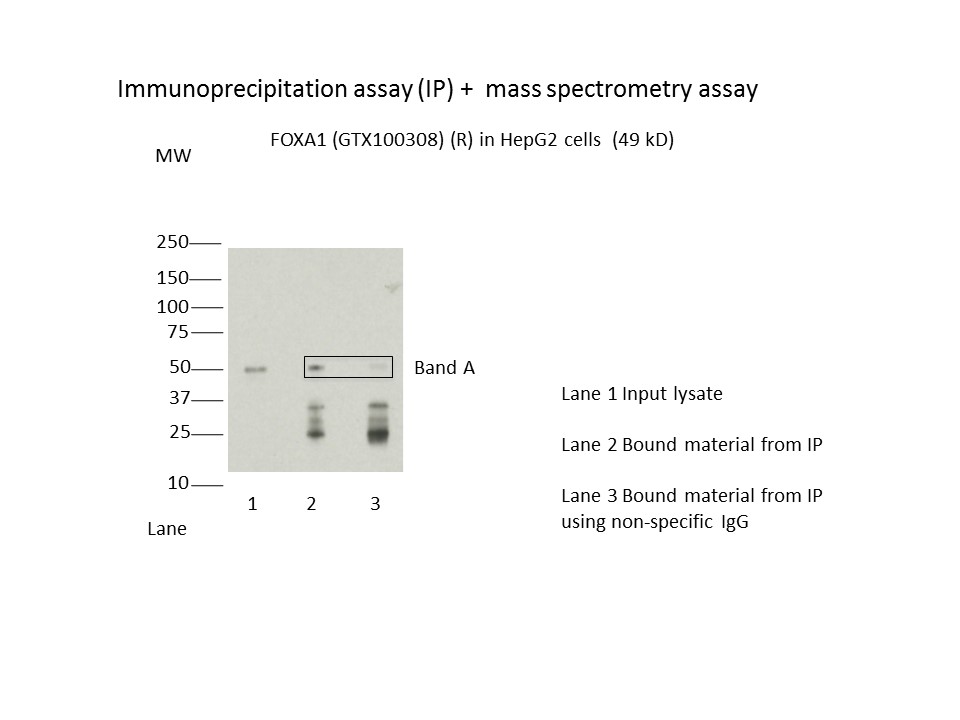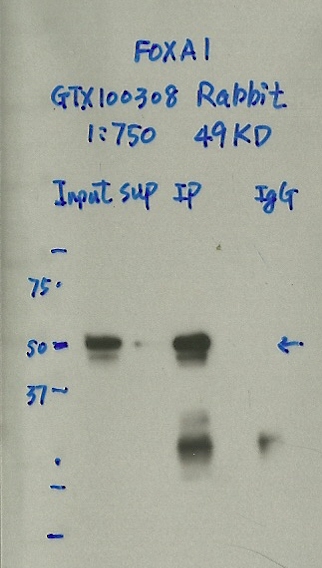ENCAB301QLE
Antibody against Homo sapiens FOXA1
Homo sapiens
MCF-7, HepG2, K562, HEK293T
characterized to standards
- Status
- released
- Source (vendor)
- GeneTex
- Product ID
- GTX100308
- Lot ID
- 39435
- Characterized targets
- FOXA1 (Homo sapiens)
- Host
- rabbit
- Clonality
- polyclonal
- Purification
- affinity
- Aliases
- michael-snyder:AS-1210
- External resources
Characterizations
FOXA1 (Homo sapiens)
HepG2
compliant
- Caption
- Immunoprecipitation of FOXA1 from HepG2 cells using GTX100308. Lane 1: input nuclear lysate. Lane 2: material immunoprecipitated with GTX100308. Lane 3: material immunoprecipitated using control IgG. Band A was excised from gel and subject to analysis by mass spectrometry. The expected band size is 49 kDa.
- Submitted by
- Kathrina Onate
- Lab
- Michael Snyder, Stanford
- Grant
- U54HG006996
- Download
- 1005_FOXA1.jpg
FOXA1 (Homo sapiens)
Method: motif enrichment
compliant
- Caption
- The motif for target FOXA1 is represented by the attached position weight matrix (PWM) derived from ENCFF507INR. Motif enrichment analysis was done by Dr. Zhizhuo Zhang (Broad Institute, Kellis Lab). Accept probability score: 0.920250256 Global enrichment Z-score: 7.761666006 Positional bias Z-score: 10.05333536 Peak rank bias Z-score: 6.646688305 Enrichment rank: 1.0
- Submitted by
- Kathrina Onate
- Lab
- Michael Snyder, Stanford
- Grant
- U54HG006996
FOXA1 (Homo sapiens)
MCF-7
compliant
- Caption
- Immunoprecipitation was performed on nuclear extracts from the cell line: MCF-7, using the antibody GTX100308. The blot shows western blot analysis of input, flowthrough, immunoprecipitate and mock immunoprecipitate using IgG.
- Submitted by
- Denis Salins
- Lab
- Michael Snyder, Stanford
- Grant
- U54HG006996
- Download
- Expt1044_0004.jpg
FOXA1 (Homo sapiens)
HepG2
not compliant
- Caption
- Immunoprecipitation was performed on nuclear extracts from the cell line: HepG2, using the antibody GTX100308. The blot shows western blot analysis of input, flowthrough, immunoprecipitate and mock immunoprecipitate using IgG.Molecular Weight: 49.148
- Submitted by
- Nathaniel Watson
- Lab
- Michael Snyder, Stanford
- Grant
- U54HG006996
- Download
- Expt1111_2-FOXA1-GTX100308_HepG2.JPG
FOXA1 (Homo sapiens)
HEK293T
compliant
- Caption
- Immunoprecipitation was performed on nuclear extracts from the cell line: HEK293T, using the antibody GTX100308. The blot shows western blot analysis of input, flowthrough, immunoprecipitate and mock immunoprecipitate using IgG.Molecular Weight: 49.148
- Submitted by
- Nathaniel Watson
- Lab
- Michael Snyder, Stanford
- Grant
- U54HG006996
FOXA1 (Homo sapiens)
K562
compliant
- Caption
- Immunoprecipitation was performed on nuclear extracts from the cell line: K562, using the antibody GTX100308. The blot shows western blot analysis of input, flowthrough, immunoprecipitate and mock immunoprecipitate using IgG.Molecular Weight: 49.148
- Submitted by
- Nathaniel Watson
- Lab
- Michael Snyder, Stanford
- Grant
- U54HG006996
- Download
- expt1111_FOXA1-GTX100308_K562.JPG
FOXA1 (Homo sapiens)
Method: immunoprecipitation followed by mass spectrometry
compliant
- Caption
- IP followed by mass spectrometry: Briefly, protein was immunoprecipitated from HepG2 nuclear cell lysates using GTX100308, and the IP fraction was loaded on a 10% polyacrylamide gel (NuPAGEBis-Tris Gel) and separated with an Invitrogen NuPAGE electrophoresis system. The gel was stained by ColloidialCoomassie G-250 stain, gel fragments corresponding to the bands indicated were excised. Then proteins were trypsinized using the in-gel digestion method. Digested proteins were analyzed on an Orbitrap Elite mass spectrometer (Thermo Scientific) by the nanoLC-ESI-MS/MS technique. Peptides were identified by the SEQUEST algorithm and filtered with a high confidence threshold (Peptide false discovery rate < 1%, 2 unique peptides per protein minimum, mass error < 10 ppm).
- Submitter comment
- For this factor, we found another TF called NONO has more peptides than targeted protein FOXA1. We would like to explain as follows: FOXA1 has interaction with AR, http://thebiogrid.org/109411/summary/homo-sapiens/foxa1.html And NONO also has interaction with AR http://thebiogrid.org/110904/summary/homo-sapiens/nono.html
- Submitted by
- Kathrina Onate
- Lab
- Michael Snyder, Stanford
- Grant
- U54HG006996
- Download
- FOXA1_Final FOXA1.pdf

